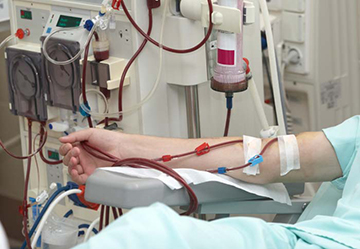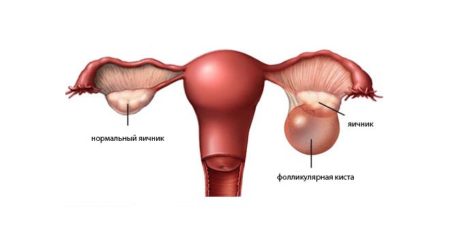Ratio of LH to. Ratio of the hormones LH and FSH in the female body
Follicle-stimulating hormone is a gonadotropic substance that is produced in the anterior part of the pituitary gland. The pituitary gland is an internal secretory gland that is located at the base of the brain. It influences growth, development and is actively involved in the metabolism of the whole organism. FSH in female body plays a key role, as it stimulates one of the main sex hormones in women - estrogen. This hormone also has an important effect in the male body. In turn, estrogen controls the production and maturation of follicles and takes an active part in the development of eggs. You can determine the level of the FSH hormone at the IVF Center clinic in Smolensk.
Luteinizing hormone is a gonadotropic hormone that, together with FSH, is produced in the anterior pituitary gland. This hormone has a very important influence on the sexual health of women and men. It stimulates the production of sex hormones in the female and male body. The maximum peak of LH levels in women is observed during the ovulatory phase menstrual cycle, which falls in its middle. At the same time, the concentration of FSH decreases significantly, and the level of progesterone and estradiol increases. If in this cycle If conception does not occur, then the desquamation phase begins and endometrial rejection occurs, which is manifested by menstrual bleeding. In this situation, the concentration of luteinizing hormone drops significantly, and the level of follicle-stimulating hormone increases with its subsequent accumulation until the next ovulation. This process has a cyclicity that corresponds to certain phases of the menstrual cycle.
Timing for delivery of gonadotropic hormones
- A venous blood test to determine the FSH level is taken 5-7 days from the start of the menstrual cycle. Men can detect this hormone at any time. This study is carried out in the morning strictly on an empty stomach. Thanks to this hormone, the female body produces the required number of follicles in the ovarian tissues, which quickly mature under the control of the FSH hormone. This also increases the production of estrogen, which stimulates the growth of the inner layer of the uterus - the endometrium. The highest FSH hormone is observed in the middle of the cycle, which ensures the onset of ovulation.
In the male body, this hormone is the main stimulator of the growth and development of the seminiferous tubules. The FSH hormone increases testosterone levels in the blood, which controls the maturation of high-quality sperm. There are situations in which this hormone functions in in full, but there are no points where it is needed. For example, this can be observed with small or very small testicles in a man who have been injured during various surgical interventions or due to an infection. - LH determination is carried out in women on the 5-7th day from the start of menstruation, and in men - on any day. This analysis blood test is performed on an empty stomach in the morning. Luteinizing hormone in the female body controls the full maturation of follicles, thereby stimulating the production of female sex hormones - estrogens. This feature contributes to the onset of ovulation of the egg and the formation of the corpus luteum. In the male body, LH ensures the formation of a specific globulin that binds sex hormones. In addition, it increases the permeability of the seminal canals for testosterone. At the same time, the level of testosterone increases significantly in the bloodstream, which stimulates the production and maturation of sperm.
In women, LH concentrations may vary depending on the phase of the menstrual cycle. The maximum content of LH in the blood is observed during ovulation of the egg, after which the concentration of this hormone decreases and remains throughout the luteal phase at a lower level compared to the first phase of menstruation. This is necessary for the normal functioning of the corpus luteum in the ovary. In the female body, elevated levels of LH in the blood are determined in the time period from 12 hours to a day before ovulation and remain at the same level throughout the day. At the same time, the levels of this hormone increase somewhere up to 9-11 times compared to non-ovulatory phases. During pregnancy, the level of this gonadotropic hormone drops.
In the case of examining women diagnosed with infertility, it is necessary to determine the ratio of LH and FSH, since these indicators are a reflection of the woman’s reproductive function. To determine this indicator, you need to divide the LH numbers by the FSH hormone. At different age periods of a woman’s life, the ratio of FSH and LH fluctuates.
The normal values of this ratio in girls before the onset of menstruation are 1, 12 months after the establishment of a regular menstrual cycle - from 1 to 1.5, and in the time period after 24 months from the end of the regular cycle and before the onset of menopause - from 1.5 to 2.
If the ratio indicators FSH hormones and LH have a value of 2.5, then this indicates:
- polycystic ovary syndrome;
- neoplasms of the pituitary gland;
- depletion of the ovarian reserve.
Reference values of FSH and LH
FSH and LH are measured in mU/ml. The values that are considered normal for luteinizing hormone in different phases of the menstrual cycle vary significantly: during the first phase of the menstrual cycle (follicular), the LH level ranges from 1.70 to 14.90; during ovulation: 22 - 55.6; in the second phase of the cycle: 0.65 - 15.8. Reference values for follicle-stimulating hormone during women's childbearing periods are as follows: follicular: 1.45 - 10; ovulatory: 6.15 - 16.8; luteal: 1.07 - 9.1. When deciphering the FSH and LH test results, the specialist compares them with the obtained figures for each individual woman. If the amount of FSH and LH in blood tests is low or high, the doctor will recognize various deviations from the norm in a woman’s reproductive or endocrine health. On reference values hormones can be affected by taking certain medications, pituitary tumors, x-ray diagnostics, renal hypofunction, and more. Various deviations from normal FSH and LH numbers force a specialist to identify the cause of this pathological process. The doctor also often uses in his practice indicators of the ratio of FSH and LH. Therapy and prevention of this process involves eliminating the influence of negative factors that led to the development of this pathology.
Pathological conditions in which the level of the FSH hormone is increased:
- intermenstrual bleeding;
- amenorrhea.
High FSH numbers are observed in women during menopause
A reduced amount of the FSH hormone is observed in the following conditions:
- increased body weight;
- hypothalamic-pituitary insufficiency.
An increased concentration of the hormone FSH is manifested by the following symptoms:
- scanty bleeding during menstruation;
- absence of the ovulatory phase;
- infertility.
Elevated LH levels are normally observed when:
- of upcoming ovulation, this hormone rises within 12-24 hours. Its elevated numbers persist after ovulation for the next day;
- The maximum peak of LH is determined in the ovulatory phase.
Pathological processes characterized by high LH levels:
- polycystic ovary syndrome;
- premature depletion of the ovarian reserve;
- kidney dysfunction;
- neoplasms of the pituitary gland;
- endometriosis;
- dysfunction of reproductive organs;
- increased physical activity;
- reduced body weight;
- emotional overload.
Reduced LH levels are typical for:
- increased body weight;
- insufficiency of the second phase of the menstrual cycle;
- smoking;
- taking certain medications;
- surgical interventions;
- amenorrhea;
- polycystic ovaries;
- Sheehan and Denny-Morphan syndrome;
- Simmonds' disease;
- emotional exhaustion;
- growth retardation;
- dysfunction of the pituitary gland and hypothalamus;
- hyperprolactinemia;
- secondary amenorrhea, which occurs due to dysfunction of the hypothalamus;
- pregnancy.
FSH and LH in ovarian failure and menopause
The positive effect of stimulating ovulation when the ovaries are depleted may not always be observed. For this purpose, the gynecologist prescribes certain drugs that block the function of the ovaries, after which they do not produce sex hormones. These medications are usually prescribed for three to six months. After this, the doctor completely cancels them. Then repeated blood tests are taken for hormone levels and the doctor looks at how they have changed. If the LH level remains above 15-20 mU/ml on the third day of the menstrual cycle, stimulating ovulation with drugs will not give the desired result. As a result, such a woman is recommended to apply for a donor egg for fertilization. During pregnancy, levels of the FSH hormone are normally reduced. LH is normally elevated during menopause.
In order for the picture of the health of a woman’s reproductive system to be as complete as possible, it is necessary to know the ratio of LH and FSH.
This will allow timely detection and treatment of serious pathologies.
What are the hormones FSH and LH
FSH and LH are hormones that play a critical role in human reproductive health. FSH is a hormone produced by the pituitary gland.
Under its influence, female and male reproductive cells are formed. By influencing the ovaries, this hormone helps the female reproductive cell to form.
In the middle of the menstrual cycle, its release from the disintegrated follicle is observed. This means that the cell is prepared for fertilization.
LH is produced by the anterior pituitary gland. Thanks to this hormone, the correct development of the reproductive system organs is stimulated.
The normal ratio of these hormones contributes to the regulation of estradiol synthesis.
Why is the ratio determined?
In the body of a girl under 12 years of age, the pituitary gland synthesizes an equal amount of these substances - LH FSH 1 1.
A change in the regulatory mechanism is observed against the background of the development of internal genital organs and changes in the body.
Puberty begins at 12-14 years of age. There is a connection between the day of the menstrual cycle and the formation of follicles in the ovaries. Normally, the cycle length is 28 days.

The cycle is divided into the following periods:
- Follicular.
- Ovulation.
- Luteal.
The release of the hormones FSH and LH is closely related to the most important sex hormones. That is why monitoring their level is so important.
According to doctors, the normal ratio of FSH and LH in the first phase varies from 1.5 to 2.
Normal amount of LH
Normal amount of FSH
The optimal amount of luteinizing hormone is presented in the tablet.
How is the analysis performed?
The day of the test is determined by the doctor. It depends on the menstrual cycle.
FSH is given on days 3-7, LH - in the middle of the follicular period. This dates back to 6-7 days.

The analysis is carried out in accordance with the following rules:
- 3-4 days before the procedure, you must give up sports training;
- tobacco and alcohol are excluded, since these products affect hormone levels;
- last meal - 12 hours before the procedure;
- The doctor must be warned about all medications taken.
The doctor does the decoding. The diagnosis is never made based on the results of the analysis. For this purpose, additional studies are ordered.
Increased concentration of hormones
The normal level of follicle-stimulating hormone varies from 3-149 units/l.
The normal content of luteinizing hormone ranges from 0.62-95 units/l.
If the FSH LH norm is violated, this does not always signal the development of pathology.
Increased FSH levels

If FSH is higher than LH, this may signal progression:
- Ovarian wasting.
- Shereshevsky-Turner syndrome.
- Testicular feminization.
- Kidney failure.
- Seminomas.
- Primary hypogonadism in males.
Increased FSH in the follicular period
With the arrival of menstruation, FSH begins to be actively produced. The cause of pituitary activity should be considered a decrease in progesterone levels.
The completion of the previous cycle is reported by receptors. Then it’s time for a new cycle.
FSH is higher than LH in the first phase. Its production has a spasmodic character. The duration of the period is 15 minutes, every 2-3 hours.
Throughout the day, the concentration of the hormone changes several times. This is due to nervous tension. Actively produced cortisol reduces the amount of sex hormone released into the blood.
Considering that FSH is greater than LH in the first phase, a follicle develops in the ovaries.
The FSH norm in the follicular period is presented in the following table:
FSH levels in men

FSH concentration increases due to:
- Use of certain medications.
- The presence of a tumor in the pituitary gland.
- Alcohol abuse.
- Kidney failure.
- Radiation received during an x-ray examination.
- Large amounts of male hormones.
- Inflammatory processes affecting the gonads.
Elevated LH levels in women
If LH prevails over FSH, this signals the development of:
- Ovarian polycystic disease.
- Disturbances of the endocrine system.
- Neoplasms in the pituitary gland.
- Endometriosis.
- Early menopause.
Also, changes in indicators can signal severe stress. It makes sense to worry when LH predominates over FSH by 2.5 times.
Elevated LH levels in men
The increased concentration of luteinizing hormone in the blood is due to:
- decreased production of testosterone;
- tumor growth in the pituitary gland;
- trauma to brain tissue;
- deterioration in the functioning of the thyroid gland;
- genetic abnormalities;
- renal pathologies;
- liver pathologies;
- chronic obstructive processes in the lungs;
- stressful situation;
- impaired absorption of nutrients.
- dysfunction of the pancreas;
- strong, sudden weight gain;
- excessively rapid weight loss;
- use of hormonal medicines;
- use of sedative medications;
- alcohol abuse.
In a man who has crossed the seventy-year mark, an increase in LH concentration is not considered a deviation from the norm.
Reduced concentration
The reason for the decrease in the concentration of these hormones can be both external and internal factors.
The exact cause can only be determined after testing.
Reduced LH levels in women
If the LH FSH ratio in women changes downward, this signals:
- an increase in the blood hormone prolactin;
- cessation of menstruation after the establishment of a cycle;
- growth retardation;
- hypogonadotropic hypogonadism;
- Simmonds disease;
- severe stress;
- Sheehan's syndrome;
- Denny-Morphan syndrome;
- absence of menstruation;
- development of obesity;
- luteal phase deficiency.
Sometimes this symptom develops due to the use of certain medications. A decrease in LH is also observed in women who smoke.

Often the concentration of the hormone decreases after surgery. The most pleasant reason for changes in LH levels is the onset of pregnancy.
At the same time, prolactin is actively produced in the body of the expectant mother.
Reduced LH levels in men
A decrease in hormone concentration is caused by:
- smoking;
- alcohol abuse;
- exhaustion;
- cryptochristism;
- the presence of a tumor in the adrenal glands;
- gonorrhea;
- testicular atrophy;
- development of STIs;
- hyperfunction of the thyroid gland;
- influence of x-rays;
- the presence of neoplasms in the brain;
- malfunction of the hypothalamus;
- neoplasm in the pituitary gland;
- disruption of the pituitary gland;
- nervous overstrain;
- physical overstrain;
- prolonged use of hormonal medications;
- long-term use of antispasmodic medications.
Another reason may be the weakening of the body after surgery.
Reduced FSH levels in women
The main factor provoking a decrease in FSH is pathological weight gain. Against this background, the estrogen content sharply decreases.
Testosterone concentration increases. This leads to digestive problems.
This is explained by the fact that testosterone helps slow down the process of protein absorption. Also, FSH deficiency signals polycystic ovarian disease.
In the worst case, we are talking about ovarian cancer. The development of cancer is explained by disruption of the endocrine system.
Deviations from the norm are observed in all sex hormones.
Pay attention!
To identify such a disorder, it is necessary to undergo an ultrasound of the pelvic organs.
Also, a decrease in FSH signals impaired functioning of the hypothalamus.
Development is observed:
- cerebrovascular accidents;
- congenital pituitary disease;
- consequences of TBI;
- encephalitis;
- meningitis.
Sometimes the hypothalamus begins to work incorrectly due to chemotherapy, which is prescribed to cancer patients. The location of the neoplasm does not play a role.
In very rare cases, a decrease in this hormone is due to a genetic predisposition. The reproductive system is not disturbed.
Reduced FSH levels in men
A decrease in the concentration of this hormone signals the absence of sperm.
This can lead to impotence. Another serious consequence of this disorder is testicular atrophy.
Conclusion
Video: LH and FSH ratio
Follicle stimulating hormone (FSH) is responsible for the growth and maturation of follicles in women and sperm in men.
Luteinizing hormone (LH) affects the functionality of the gonads and promotes the production of sex hormones - progesterone and testosterone.
The optimal ratio of LH and FSH hormones in the body ensures healthy reproductive function.
The amount of FSH and LH in a man depends on the level of testosterone (based on the feedback principle). When its amount is reduced, the production of FSH and LH increases. If it is elevated, less FSH and LH hormones are produced.
The balance of gonadotropic hormones in the male body looks like this:
- LG - That's 0.5 to 10.0;
- FSH - from 1.5 to 12.
The amount of hormone in the blood is measured in international units. This is usually mIU/ml.
The ratio of these hormones in the female body largely depends on the phase of the menstrual cycle. The normal ratio is 1:2.5 (LH:FSH), which occurs at the beginning of the cycle.
Hormone levels, including LH and FSH in women, change as often as hormonal levels:
- with the arrival of menstruation;
- with the onset of pregnancy;
- after childbirth and during menopause.
In men, the levels of LH and FSH are normally more stable, since they are not subject to such frequent hormonal changes as the fair sex.
Ratio in women
As already mentioned, the level of gonadotropic hormones in women is constantly changing. It depends:
- From days of the menstrual cycle: FSH predominates initially (the cycle phase is called the follicular phase), and then LH (luteal phase).
- From age: The level of hormones in the blood of a girl who does not have regulation is quite low, with a predominance of FSH. With the onset of menstruation, the amount of LH and FSH in the blood increases, and over time it is established within the limits characteristic of women, changing with the periods of the cycle.

- The follicular phase begins with the onset of menstruation. At this time, the amount of FSH is greater than LH (1.9-11.0 versus 1.4-8.6). The process of maturation of follicles with the production of estrogens occurs.
- Next, in the middle of the cycle, the ovulatory phase begins. At this time, FSH indicators reach 4.8-20.5, and LH - 14.3-75.8.
- The period of ovulation is replaced by the luteal phase and is characterized by a decrease in the level of gonadotropic hormones: FSH drops to 1-9, LH - to 1-14.
With age, menopause comes into a woman's life. The pituitary gland still produces LH and FSH, but the ovaries produce less and less estrogen. This leads to an excess of gonadotropic hormones in the blood.
Typical age indicators at this time are:
- FSH - 30-128 mIU/ml;
- LH - 19-73 mIU/ml.
Such a high content of them negatively affects a woman’s well-being.
 During pregnancy, a woman's body experiences significant hormonal changes.
During pregnancy, a woman's body experiences significant hormonal changes.
The volume of production of both luteinizing and follicle-stimulating hormones is significantly reduced.
After the birth of the child and the end of the period breastfeeding the number of gonadotropes returns to normal.
As for the ratio of LH and FSH in the female body, the normal indicators are as follows:
- for girls who do not menstruate - 1:1;
- a year after the onset of regulation - 1:1.15;
- after 2 years and with the onset of menopause - 1.5:2.
Ratio in men
FSH in a man’s body plays an important role in procreation: it is responsible for spermatogenesis and stimulates the production of estradiol.

The normal FSH level in a man is as follows:
- before puberty: FSH - 0.1-5; LH-0.1-5;
- from 18 to 70 years: FSH - 1.5-15, LH - 1.5-9.3;
- during andropause: FSH - 37-100, LH - 3.1-34.
If it is higher, it may:
- be a sign of chronic renal failure;
- talk about the presence of malignant tumors in the pituitary gland;
- signal problems in the reproductive system.
 If the FSH level is below normal, it may be:
If the FSH level is below normal, it may be:
- due to obesity;
- a sign of dysfunction of the pituitary gland;
- consequences of taking anabolic steroids;
- the result of starvation.
Luteinizing hormone, like FSH, is responsible for the development and functioning of the gonads, as well as the release of sex hormones.
The amount of LH can change several times during the day because its release into the blood occurs impulsively.
An increase in LH can occur for the following reasons:
- tumor processes in the pituitary gland;
- chromosomal disorders;
- congenital pathologies;
- previous infectious diseases that affected reproduction (epidemiological paporitis, or mumps; gonorrhea);
- great physical activity;
- taking hormone-containing drugs.
- functional disorders of the hypothalamus and pituitary gland;
- chronic form of stress;
- obesity;
- complications after surgical operations;
- taking anabolic steroids;
- bad habits (smoking, addiction to alcohol).
Maintaining a normal ratio of FSH and LH in a man’s blood ensures the necessary level of testosterone, which is important:
- for a normal and stable emotional background;
- maintaining muscle strength and sexual activity;
- for the possibility of conceiving a child even in adulthood.
The level of FSH and LH in the male body is not constant. The ratio of these hormones can also be different. If the amount of LH and FSH can tell about the state of the male body, then their relationship with each other has no diagnostic value.
How to calculate the ratio of LH and FSH?
Hormone levels are determined through a blood test.
 To calculate the ratio of LH and FSH, you need to divide the first laboratory indicator by the second.
To calculate the ratio of LH and FSH, you need to divide the first laboratory indicator by the second.
Whatever it turns out to be, you should not interpret it yourself. As mentioned above, many factors influence hormone levels.
Therefore, if the ratio of LH and FSH is not ideal, only a doctor can talk about the presence of any pathology.
The results of hormone levels in the body are also influenced by how a person prepared for the research.
Blood testing should be done on an empty stomach, in the morning, after an overnight fast of 8 to 12 hours.
If there are reasons that do not allow you to come for analysis in the morning, you can do it in the afternoon. In this case, in the morning you should give up a fatty, high-calorie breakfast - it should be light, and in the afternoon, 6 hours before your visit to the clinic, eat nothing.
So, in order for a blood test for the content of FSL and LH to be reliable, one must keep in mind that:
- In women, hormonal levels are highly dependent on the cycle, so blood should be donated on the days determined by the doctor. For FSH this is usually 3-7 (to determine the dynamics of follicle growth - 5-8) days of the cycle, and for LH - 6-7. Naturally, these conditions have nothing to do with men, so they can donate blood any day.
- The results of the examination may be affected by medications taken during the examination period. Therefore, you should tell your doctor about all medications you are taking, including vitamin supplements and birth control pills.
- The test is taken on an empty stomach.
- A few days before donating blood for testing, you should refrain from physical activity and stop drinking alcohol and cigarettes.
Video on the topic
There are many sex hormones in the female body that make it possible to become pregnant and give birth to a child. But this possibility is most influenced by the ratio of LH and FSH. The normal ratio is considered a sign of proper ovarian function. Therefore, analysis of the LH norm to the FSH norm is important to establish the causes of the inability to get pregnant and other pathological abnormalities in the woman’s reproductive system.
What are FSH and LH
FSH is a follicle-stimulating hormone that ensures the production of estrogen, the main female sex hormone. Depends on estrogen proper development follicles, quality and quantity of eggs.
LH is a luteinizing substance that regulates all processes of the reproductive system.
The highest levels of this substance, estradiol and progesterone, are recorded during ovulation. At the same time, the hormone that can stimulate follicles reduces the concentration.
If a man fails to fertilize a girl, the amount of the hormone in her body that can luteinize sharply decreases, and the amount of follitropin becomes higher. This ratio of LH and FSH, the norm when planning pregnancy, helps couples who are unable to have a child. This process is cyclical and is associated with the menstrual cycle.
Important! Prolactin, folliropin and LH are enzymes produced by the pituitary gland. The cells responsible for the process are called gonadotrophs, which is why the enzymes are often generalized with the word “gonadotropic”.
The normal ratio of FSH to LH is closely related to the functionality of the ovaries, which is why it is given such great importance when diagnosing infertility.
The ratio of LH and FSH, the norm in women
When planning a pregnancy, the LH and FSH levels are checked first. If one of the hormones is abnormal, conception will not occur due to lack of ovulation.
Since the individual significance of LH and follitropin is important, the specialist will refer the woman to analyze the concentration of each substance.
The generally accepted norm of follicle-stimulating hormone
- Follicle size – 3.2 – 14 mU/ml.
- Ovulation – 5.1 – 24 mU/ml.
- Luteal – 5 – 13 honey/ml.
Acceptable LH levels:
- Follicle size – 3 – 13.8 mU/ml.
- Ovulation – 22 – 161 honey/ml.
- Luteal – 3 – 18 honey/ml.
Ovulation
The effect of age on the ratio of LH and FSH:
- Girls at the beginning of puberty – 1:1.
- Women with a mature reproductive system - 2:1 (excess of LH over follitropin).
For the first phase monthly cycle It is normal for follitropin to exceed the luteinizing substance; the second phase is characterized by opposite indications.
How to get tested correctly
In order for the study to show the correct result, the woman must prepare for it and decide on the day of the menstrual cycle on which the blood will be drawn.
- Do not use nicotine the day before blood collection.
- Do not eat 10 hours before the procedure.
- Eliminate alcohol consumption for 36 hours.
- Minimize force loads.
- Avoid stressful situations and nervous tension.

Do not eat food before the test
For example: blood for analysis is taken between days 3-9 of the cycle, since at this time the ratio of LH to FSH is almost stable. Individually, one of the hormones may predominate.
FSH and LH levels are above normal
The main reasons that cause this violation of acceptable indicators include:
- Ovarian cyst.
- Androgen resistance.
- Ovarian failure.

Ovarian cyst
Please pay attention! High indicators follitropin and luteinizing hormone – normal sign menopause And menopause.
If the study recorded a high concentration of FSH, this may provoke non-standard bleeding. Also, this deviation from the norm may be a harbinger of early menopause.
High levels of the ratio of LH to follitropin can cause irreparable harm to a woman’s body, so if the analysis shows this, you should urgently consult a doctor. He is obliged to select therapy taking into account the patient’s individual characteristics.
FSH and LH levels are below acceptable values
The reasons for this study result include:
- Underdeveloped mammary glands.

Underdeveloped mammary glands
- Anovulation.
- Scanty periods.
- Sexual apathy.
- Underdeveloped genitals.
- Pathological development of the reproductive system.
The above ailments are detected before the age of 21. During this period, normalizing the ratio is not difficult; short-term drug therapy is sufficient. If time is lost, it is almost impossible to cure a woman and restore her ability to bear a child.
When the LH to Follitropin Ratio is Critical
The analysis is important if an infertile woman over 36 years of age wants to become pregnant using the IVF procedure. This is explained by two physiological phenomena:
- Approaching menopause.
- A rapid decrease in the ovarian reserve of the ovaries, which leads to a decrease in eggs ready for fertilization.
Age negatively affects the quantity and quality of eggs. With their reduced concentration, natural and IVF fertilization is problematic. The risk of embryo rejection increases.
At elevated levels FSH for a woman propose to use donor eggs as alternative way get pregnant. According to statistics, the technique helps 37 percent of infertile women.
The concentration of follicle-stimulating and luteinizing hormone is the object of constant monitoring by the doctor and the patient. This ratio can be calculated using a regular calculator, the main thing is to take into account the age range.
If the test result is abnormal, this can be regarded as a symptom of pathologies in the female body. Finding the root cause and treating ailments is the direct responsibility of the doctor, so the patient is prohibited from self-medicating.
Hormonal imbalances detected in the early stages of development are amenable to therapeutic measures. To do this, the woman is prescribed special hormonal medications, adjusts her lifestyle and insists on giving up bad habits. If you follow medical recommendations, a woman will receive a good result from treatment and will be able to get pregnant faster.




